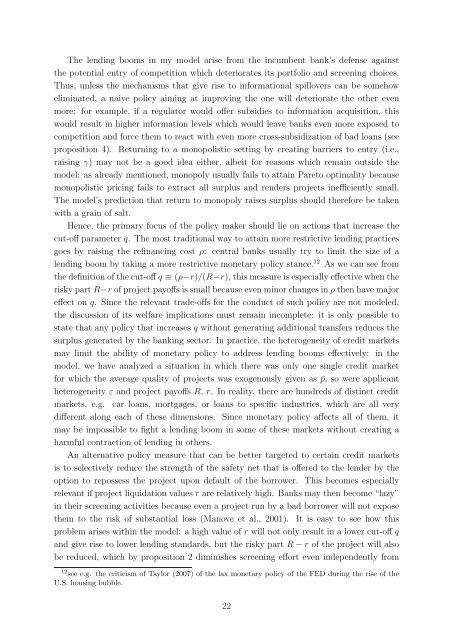Bank Competition, Information Choice and Inefficient Lending Booms
Bank Competition, Information Choice and Inefficient Lending Booms
Bank Competition, Information Choice and Inefficient Lending Booms
You also want an ePaper? Increase the reach of your titles
YUMPU automatically turns print PDFs into web optimized ePapers that Google loves.
The lending booms in my model arise from the incumbent bank’s defense against<br />
the potential entry of competition which deteriorates its portfolio <strong>and</strong> screening choices.<br />
Thus, unless the mechanisms that give rise to informational spillovers can be somehow<br />
eliminated, a naive policy aiming at improving the one will deteriorate the other even<br />
more: for example, if a regulator would offer subsidies to information acquisition, this<br />
would result in higher information levels which would leave banks even more exposed to<br />
competition <strong>and</strong> force them to react with even more cross-subsidization of bad loans (see<br />
proposition 4). Returning to a monopolistic setting by creating barriers to entry (i.e.,<br />
raising γ) may not be a good idea either, albeit for reasons which remain outside the<br />
model: as already mentioned, monopoly usually fails to attain Pareto optimality because<br />
monopolistic pricing fails to extract all surplus <strong>and</strong> renders projects inefficiently small.<br />
The model’s prediction that return to monopoly raises surplus should therefore be taken<br />
with a grain of salt.<br />
Hence, the primary focus of the policy maker should lie on actions that increase the<br />
cut-off parameter q. The most traditional way to attain more restrictive lending practices<br />
goes by raising the refinancing cost ρ: central banks usually try to limit the size of a<br />
lending boom by taking a more restrictive monetary policy stance. 12 As we can see from<br />
the definition of the cut-off q ≡ (ρ−r)/(R−r), this measure is especially effective when the<br />
risky part R−r of project payoffs is small because even minor changes in ρ then have major<br />
effect on q. Since the relevant trade-offs for the conduct of such policy are not modeled,<br />
the discussion of its welfare implications must remain incomplete: it is only possible to<br />
state that any policy that increases q without generating additional transfers reduces the<br />
surplus generated by the banking sector. In practice, the heterogeneity of credit markets<br />
may limit the ability of monetary policy to address lending booms effectively: in the<br />
model, we have analyzed a situation in which there was only one single credit market<br />
for which the average quality of projects was exogenously given as ¯p, so were applicant<br />
heterogeneity ε <strong>and</strong> project payoffs R, r. In reality, there are hundreds of distinct credit<br />
markets, e.g. car loans, mortgages, or loans to specific industries, which are all very<br />
different along each of these dimensions. Since monetary policy affects all of them, it<br />
may be impossible to fight a lending boom in some of these markets without creating a<br />
harmful contraction of lending in others.<br />
An alternative policy measure that can be better targeted to certain credit markets<br />
is to selectively reduce the strength of the safety net that is offered to the lender by the<br />
option to repossess the project upon default of the borrower. This becomes especially<br />
relevant if project liquidation values r are relatively high. <strong>Bank</strong>s may then become “lazy”<br />
in their screening activities because even a project run by a bad borrower will not expose<br />
them to the risk of substantial loss (Manove et al., 2001). It is easy to see how this<br />
problem arises within the model: a high value of r will not only result in a lower cut-off q<br />
<strong>and</strong> give rise to lower lending st<strong>and</strong>ards, but the risky part R − r of the project will also<br />
be reduced, which by proposition 2 diminishes screening effort even independently from<br />
12 see e.g. the criticism of Taylor (2007) of the lax monetary policy of the FED during the rise of the<br />
U.S. housing bubble.<br />
22
















